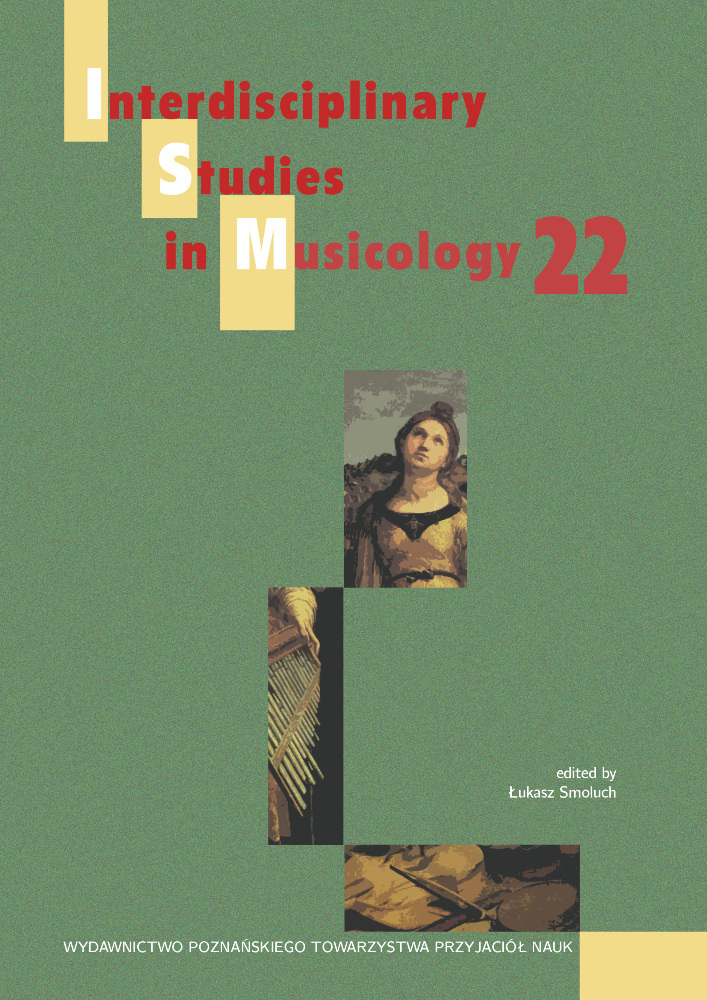Abstrakt
The choice of research method significantly affects the course of research itself. It is becoming increasingly common to see cases of methods from various fields combined to achieve the required results. This is exemplified by the use of a quantitative method in traditional score analysis to verify premises in the field of music psychology. The article addresses the previous views of traditional musicology on the use of natural methods in the field and presents instances of the usefulness of the quantitative method in music research. In the second part, by referring to musical-rhetorical figures, it is shown how this method can deepen the knowledge of both musical-rhetorical figures and have a valuable contribution to the psychology of music.
Bibliografia
Anderson, C. J., & Schutz, M. (2022). Exploring historic changes in musical communication: Decon- structing emotional cues in preludes by Bach and Chopin. Psychology of Music, 50(5): 1424–1442. DOI: https://doi.org/10.1177/03057356211046375
Ariza, C., & Cuthbert, M. S. (2010). Modeling beats, accents, beams, and time signatures hierarchically with Music21 meter objects. International Computer Music Conference.
Bartel, D. (1997). Musica poetica: Musical-rhetorical figures in German baroque music. University of Nebraska Press.
Board, R. (2006). Dietrich Buxtehude’s Membra Jesu Nostri: a study in baroque affections and rhetoric. University of Missouri.
Bowling, D. L., Sundararajan, J., Han, S., & Purves, D. (2012). Expression of emotion in Eastern and Western music mirrors vocalization. PLoS ONE, 7(3). DOI: https://doi.org/10.1371/journal.pone.0031942
Cuthbert, M. S., & Ariza, C. (2010). music21: A toolkit for computer-aided musicology and symbolic music data. 11th International Society for Music Information Retrieval Conference. http://web.mit.edu/music21
Cuthbert, M. S., Ariza, C., & Friedland, L. (2011). Feature extraction and machine learning on symbolic music using the music21 toolkit. 12th International Society for Music Information Retrieval Conference. http://mit.edu/music21.
Domańska, E. (2010). Jakiej metodologii potrzebuje współczesna humanistyka? Teksty Drugie Nr 1–2 (2010): 1–2.
Ekman, P., Levenson, R. W., & Friesen, W. v. (1983). Autonomic nervous system activity distinguishes among emotions. Science, 221(4616): 1208–1210. DOI: https://doi.org/10.1126/science.6612338
Fubini, E. (2002). Historia estetyki muzycznej. Musica Iagellonica.
Huron, D. (1999). The new empiricism: systematic musicology in a postmodern age. University of California.
Huron, D. (2006). Sweet Anticipation. The MIT Press. DOI: https://doi.org/10.7551/mitpress/6575.001.0001
Huron, D. (2008). A comparison of average pitch height and interval size in major-and minor-key themes: Evidence consistent with affect-related pitch prosody. EmpiricalMusicologyReview, 3(2).
Jabłoński, M. (2002). Wmyślanie się w muzykologię. Res Facta Nova, 5(14): 57–105.
Jabłoński, M. (2014). Przeciw muzykologii niewrażliwej. Wydawnictwo Nauka i Innowacje.
Juslin, P. N., & Västfjäll, D. (2008). Emotional responses to music: The need to consider underly- ing mechanisms. Behavioral and Brain Sciences, 31(5): 559–575. DOI: https://doi.org/10.1017/S0140525X08005293
Kolinski, M. (1959). The evaluation of tempo. Ethnomusicology, 3(2): 45. DOI: https://doi.org/10.2307/924285
Korolko, M. (1990). Sztuka retoryki. Przewodnik encyklopedyczny. Wiedza Powszechna.
Lisecki, W. (1993). Vademecum muzycznej »ars oratoria«. Canor, 6.
Matejun, M. (2021). Metodyka badań ilościowych. In Ł. Sułkowski, R. Lenart-Gansiniec, & R. Lenart-Gansiniec (Eds.), Metody badań ilościowych w zarządzaniu (pp. 161–188). Wydawnictwo Społecznej Akademii Nauk.
Mehr, S. A., Singh, M., Knox, D., Ketter, D. M., Pickens-Jones, D., Atwood, S., Lucas, C., Jacoby, N., Egner, A. A., Hopkins, E. J., Howard, R. M., Hartshorne, J. K., Jennings, M. v., Simson, J., Bainbridge, C. M., Pinker, S., O’Donnell, T. J., Krasnow, M. M., &Glowacki, L. (2019). Universality and diversity in human song. Science, 366(6468). DOI: https://doi.org/10.1126/science.aax0868
Mehr, S. A., Singh, M., York, H., Glowacki, L., & Krasnow, M. M. (2018). Form and function in hu- man song. Current Biology, 28(3): 356–368.e5. DOI: https://doi.org/10.1016/j.cub.2017.12.042
Paczkowski, S. (1998). Nauka o afektach w myśli muzycznej I połowy XVII wieku. Polihymnia.
Schellenberg, E. G., Peretz, I., & Vieillard, S. (2008). Liking for happy- and sad-sounding music: Effects of exposure. Cognition and Emotion, 22(2): 218–237. DOI: https://doi.org/10.1080/02699930701350753
Scherer, K. R. (1995a). How emotion is expressed in speech and singing? 13th International Congress of Phonetic Sciences, Vol. 3: 90–96.
Scherer, K. R. (1995b). Expression of emotion in voice and music. Journal of Voice, 9(3), 235–248. DOI: https://doi.org/10.1016/S0892-1997(05)80231-0
Scherer, K. R., & Zentner, M. R. (2001). Emotional effects of music: production rules. Music and Emotion: Theory and Research, 361–392. DOI: https://doi.org/10.1093/oso/9780192631886.003.0016
Sloboda, J., &Juslin, P. N. (2001). Psychological perspectives on music and emotion. Music and Emotion Theory and Research, 71–104. http://psycnet.apa.org/psycinfo/2001–05534–001 DOI: https://doi.org/10.1093/oso/9780192631886.003.0004
Sun, S. H., & Cuthbert, M. S. (2017). Emotion painting: Lyric, affect, and musical relationships in a large lead-sheet corpus. Empirical Musicology Review 12(4): 327–348. DOI: https://doi.org/10.18061/emr.v12i3-4.5889
Sztumski, J. (2005). Wstęp do metod i technik badań społecznych. Wydawnictwo naukowe “Śląsk”.
Wilson, B., Buelow, G. J., & Hoyt, P. A. (2001). Rhetoric and music (Vol. 1). Oxford University Press. DOI: https://doi.org/10.1093/gmo/9781561592630.article.43166
Licencja
Prawa autorskie (c) 2022 Marianna Kowal, Monika Woźniak

Utwór dostępny jest na licencji Creative Commons Uznanie autorstwa – Bez utworów zależnych 4.0 Międzynarodowe.

